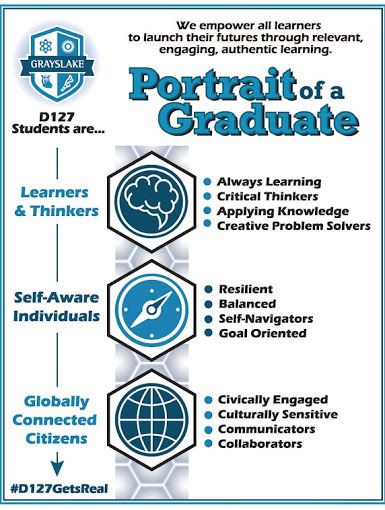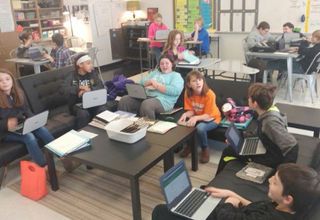Changing Pedagogy— Supporting Teachers in New Ways with Technology

Forward-thinking schools are using technology to change how teachers and students interact and work together as well as to help students take more responsibility for their own learning.
At the recent Tech & Learning Leadership Summit in Phoenix, a group of education leaders discussed how they are preparing students for success in a technological world of innovation.
Dr. Mikkel Storaasli, superintendent, and Dr. Michael Marassa, director of technology, at Grayslake Community High School District 127 in Illinois shared their vision for how curriculum, instruction, and assessment can support learners for success in a world of innovation.
In the creation of a “Portrait of a Graduate,” district leaders determined the skills a graduate needs to be successful in a new, dynamic marketplace of innovation. Graduates need to know how to think critically and work collaboratively with others to solve problems. The question then becomes how to use technology to change curriculum and instruction to support that outcome?
Curriculum, instruction, and assessment practices will leverage the full range of technology and other school and community resources to ensure students are immersed in rich, authentic, relevant learning experiences that enable 21st-century skills and deeper learning across the disciplines. —District 127 Vision Statement
In order to achieve this vision, Grayslake leaders promised teachers they would have “robust and adaptive tools to customize the instruction . . . on a student-to-student basis to ensure relevance and deep understanding of complex issues and topics.”
Mission, instruction and learning, and technology coalesced around four goals:
■ Establish an instructional, curricular, and assessment framework that promotes relevant, engaging, authentic learning.
■ Ensure all students are physically, mentally, and emotionally prepared to meet future challenges.
■ Develop relationships and consistent communication procedures.
■ Leverage effective use of resources for the benefit of student learning.
SIMILAR GOALS—DIFFERENT PATHS

Although most districts have articulated a technology plan, shifting instructional practices takes time, so district efforts at changing pedagogy are wide and varied. Julie Morgenthal, director of technology services in Phoenix, Arizona, reports that their current focus is on moving teachers toward using technology at higher SAMR levels to increase rigor and engagement. “This involves teaching administrators and coaches to model higher levels of tech use and to encourage innovation.”
Andrew Wheelock, technology integrator at Erie 1 BOCES in West Seneca, New York, shared a sample of one of the courses they developed as part of an Online Academy for Teachers to model successful ways to incorporate technology. Skokie (IL) School District 68 is embedding technology ideas into curriculum planning, modeling technology in meetings, and using their instructional coaches/librarians as resources, says Nancy Battaglia, director of technology.
For Webster (NY) Central Schools, the focus is on professional development that helps teachers understand that instruction comes first and technology is a tool that needs to be integrated when appropriate, says Joe Montemaro, director of technology. He reports they are now using the TPACK framework to help their administrators know what the integration looks like at the nexus of technology, pedagogy, and content knowledge.
The district goal for Putnam County Schools in Algood, Tennessee, is to assist students in taking ownership of their learning and becoming future ready. They support the teachers to deliver personalized learning. They began with the concept of blended learning and flipped classrooms, says Donna Sherrell, EPSO specialist and online teacher. Then teachers began to redesign how their classrooms operate—creating a more relaxed and inviting atmosphere. “Students are learning not only how to use technology but how to communicate and collaborate with their group.”
Christine Choi, assistant director for technology, leadership, and innovation for Broome-Tioga BOCES in Binghamton, New York, says their efforts also focus on professional learning sessions for teachers. Each of their sessions focuses on active learning experiences for students that support the Pre-K–12 progression of technology skills. They’ve also partnered with the district instructional coach administrator to enhance the elements of effective instruction, including instructional technology. They’ve followed this up with classroom observations at all levels with small administrative teams, as this provides the opportunity to practice and share with each other.
INTERNATIONAL PARTNERS—A NEW FRONTIER
One of the most interesting approaches to changing pedagogy was shared by Robert Gerardi, superintendent of Maynard (MA) Public Schools. He reported that they’re working with an international organization called Global STEM Network. They’re linking their anatomy and physiology teacher with a teacher in France to co-teach via video conferencing.
Students will be placed in project groups with international students and will need to make a public presentation at the end on how artificial intelligence can solve real-world problems in anatomy and physiology. They’ll be able to learn and perform experiments simultaneously.
Gerardi notes that Global STEM Network has the connections to link schools in many countries in Europe and Asia.
Tech & Learning hosts four Leadership Summits each year where district leaders gather to exchange ideas like these. If you’d like to be considered for a 2019 Summit, you may submit your application here. https://www.surveymonkey.com/r/TLSummit19
Tech & Learning Newsletter
Tools and ideas to transform education. Sign up below.
Annie Galvin Teich has more than 25 years' experience in education writing and publishing. She is an edtech industry expert in content marketing and copywriting. As a regular contributor to Tech & Learning she focuses on the information needs of district decision makers.













